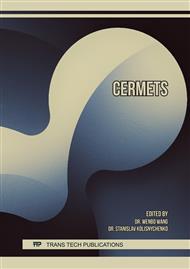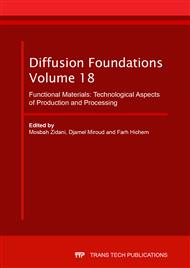[1]
Y. Sechi, K. Nagatsuka, and K. Nakata, Dissimilar laser brazing of h-BN and WC-Co alloy in Ar atmosphere without evacuation process,, J. Phys. Conf. Ser., vol. 379, p.12048, (2012).
DOI: 10.1088/1742-6596/379/1/012048
Google Scholar
[2]
L. Emanuelli, M. Pellizzari, A. Molinari, F. Castellani, and E. Zinutti, Reprint of 'Thermal fatigue behaviour of WC-20Co and WC-30(CoNiCrFe) cemented carbide,', Int. J. Refract. Met. Hard Mater., vol. 62, p.176–182, (2016).
DOI: 10.1016/j.ijrmhm.2016.10.019
Google Scholar
[3]
K. Nagatsuka, Y. Sechi, Y. Miyamoto, and K. Nakata, Characteristics of dissimilar laser-brazed joints of isotropic graphite to WC – Co alloy,, Mater. Sci. Eng. B, vol. 177, no. 7, p.520–523, (2012).
DOI: 10.1016/j.mseb.2011.12.014
Google Scholar
[4]
H. Chen, K. Feng, J. Xiong, and Z. Guo, Characterization and stress relaxation of the functionally graded WC-Co/Ni component/stainless steel joint,, J. Alloys Compd., vol. 557, p.18–22, (2013).
DOI: 10.1016/j.jallcom.2012.12.152
Google Scholar
[5]
M. I. Barrena, J. M. Gómez de Salazar, N. Merino, and L. Matesanz, Characterization of WC-Co/Ti6Al4V diffusion bonding joints using Ag as interlayer,, Mater. Charact., vol. 59, p.1407–1411, (2008).
DOI: 10.1016/j.matchar.2007.12.008
Google Scholar
[6]
M. I. Barrena, J. M. Gómez de Salazar, and L. Matesanz, Interfacial microstructure and mechanical strength of WC-Co/90MnCrV8 cold work tool steel diffusion bonded joint with Cu/Ni electroplated interlayer,, Mater. Des., vol. 31, no. 7, p.3389–3394, (2010).
DOI: 10.1016/j.matdes.2010.01.050
Google Scholar
[7]
M. Uzkut, N. K. Sinan, and B. S. Unl, The determination of element diffusion in connecting SAE 1040 / WC material by brazing,, vol. 169, p.409–413, (2005).
DOI: 10.1016/j.jmatprotec.2005.05.001
Google Scholar
[8]
H. Chen, K. Feng, S. Wei, J. Xiong, Z. Guo, and H. Wang, Microstructure and properties of WC – Co / 3Cr13 joints brazed using Ni electroplated interlayer,, Int. J. Refract. Met. Hard Mater., vol. 33, p.70–74, (2012).
DOI: 10.1016/j.ijrmhm.2012.02.018
Google Scholar
[9]
W. B. Lee, B. D. Kwon, and S. B. Jung, Effects of Cr3C2 on the microstructure and mechanical properties of the brazed joints between WC-Co and carbon steel,, Int. J. Refract. Met. Hard Mater., vol. 24, p.215–221, (2006).
DOI: 10.1016/j.ijrmhm.2005.04.003
Google Scholar
[10]
R. Spliegler, S. Schmauder, and L. S. Sigl, Fracture toughness evaluation of WC-Co alloys by indentation testing,, J. hard Mater., vol. 1, no. 3, p.147–158, (1990).
Google Scholar
[11]
S. Sheikh, R. M. Saoubi, P. Flasar, M. Schwind, T. Persson, J. Yang, and L. Llanes, Int . Journal of Refractory Metals and Hard Materials Fracture toughness of cemented carbides : Testing method and microstructural effects,, (2014).
DOI: 10.1016/j.ijrmhm.2014.08.018
Google Scholar
[12]
D. K. Shetty, I. G. Wright, P. N. Mincer, and A. H. Clauer, Indentation fracture of WC-Co cermets,, J. Mater. Sci., vol. 20, no. 5, p.1873–1882, (1985).
DOI: 10.1007/bf00555296
Google Scholar
[13]
C. Jiang, H. Chen, Q. Wang, and Y. Li, Effect of brazing temperature and holding time on joint properties of induction brazed WC-Co / carbon steel using Ag-based alloy,, J. Mater. Process. Technol., vol. 229, p.562–569, (2016).
DOI: 10.1016/j.jmatprotec.2015.09.044
Google Scholar
[14]
B. Cheniti, D. Miroud, R. Badji, D. Allou, T. Csanádi, M. Fides, and P. Hvizdoš, Effect of brazing current on microstructure and mechanical behavior of WC-Co/AISI 1020 steel TIG brazed joint,, Int. J. Refract. Met. Hard Mater., vol. 64, p.210–218, (2016).
DOI: 10.1016/j.ijrmhm.2016.11.004
Google Scholar



